|
|
|
| Motorbike
Adventures
in Laos… |
| with
Siam Bike Travel |
Part
3: Let's
Go
Next morning
we suit up and sweet-talk our itchy right hands to be patient for just
a few more kilometers. 90 kms of finest dirt road to Viang Pukha are waiting
for us. In single file, we parade down Hua Xai main street and say good-bye
to electricity, cold beer, hot showers and the Thai transponder which
linked us to the rest of the world through Walter's mobile phone. Now
he's carrying just a pretty assembly of plastic, silicon, lithium and
a couple of ions. There are still limits to all this great technology.
Once out
of town, we moved along, with the wide dirt road and good visibility allowing
speeds between 50 and 90 kph. We are well aware that a single accident
will be quite a slowdown for the whole group. The backup car has to collect
the poor guy, drive him back to Hua Xai, which means that we're without
one of the guides, and, what's worse, without the backup car which carries
our luggage - no fresh clothes. Don't race, fellows. This is the wrong
place. Walter has made it quite clear that everybody has to ride well
within his personal safety limits and, above all, within visibility. "Always
expect a water buffalo around the next corner!"
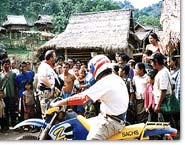 Siam
Bike Travel has been in this business for years. They checked us out on
the first day riding in the hills around Chiang Mai and they know how
to coach inexperienced riders within the first few days to get them up
to speed and keep an eye on them. But this group is quite experienced
and we do 15 to 20-minute bursts of extremely fine riding. Basically it's
from village to village. You have to slow down anyway to go through a
sleepy village. Once the first rider has entered the village, all the
kids come around screaming, laughing and shouting. The village elders
will come to see what's going on and then the rest of the village follows.
We've never experienced anything like this. You are a total alien to these
people. Decked out in full off-road gear, sitting on bikes as tall as
they've ever seen before, we are just out of this world for them. But
a few smiles, gestures and friendly words get conversations going. They
all hunt and proudly present their muzzle loaders, which are usually 6
or 7 foot tall, looking funny when they belong to hunters measuring barely
5 feet. The whole village gathers around our group, inviting us to stay
or at least to have a few rice whiskeys with them. Walter tells us that
sometimes a group had to take them up on their offers for bed and breakfast,
when a bike needed repairs after a river crossing or when the weather
was extremely bad. They admire our off-road gear, checking out the elbow
and knee protectors, but absolutely love the plastic chest protectors.
One guy points at his ancient muzzleloader, then knocks at my chest protector
and says something in Lao. "He wants to know if it's bullet proof, too",
Walter translates. I'm tempted to say "Yes", but then the little hunter
might just try it out. Most villagers have never seen a "Farang", a westerner,
before. One of our guys has a bit of a beard, and the women come and take
a look at this strange man with hair on his face. Like most Asians, Lao
hill tribe men don't have facial hair. Accompanied by giggles and laughter
from the other women, one little old lady even touches it to tell them
how it feels! Siam
Bike Travel has been in this business for years. They checked us out on
the first day riding in the hills around Chiang Mai and they know how
to coach inexperienced riders within the first few days to get them up
to speed and keep an eye on them. But this group is quite experienced
and we do 15 to 20-minute bursts of extremely fine riding. Basically it's
from village to village. You have to slow down anyway to go through a
sleepy village. Once the first rider has entered the village, all the
kids come around screaming, laughing and shouting. The village elders
will come to see what's going on and then the rest of the village follows.
We've never experienced anything like this. You are a total alien to these
people. Decked out in full off-road gear, sitting on bikes as tall as
they've ever seen before, we are just out of this world for them. But
a few smiles, gestures and friendly words get conversations going. They
all hunt and proudly present their muzzle loaders, which are usually 6
or 7 foot tall, looking funny when they belong to hunters measuring barely
5 feet. The whole village gathers around our group, inviting us to stay
or at least to have a few rice whiskeys with them. Walter tells us that
sometimes a group had to take them up on their offers for bed and breakfast,
when a bike needed repairs after a river crossing or when the weather
was extremely bad. They admire our off-road gear, checking out the elbow
and knee protectors, but absolutely love the plastic chest protectors.
One guy points at his ancient muzzleloader, then knocks at my chest protector
and says something in Lao. "He wants to know if it's bullet proof, too",
Walter translates. I'm tempted to say "Yes", but then the little hunter
might just try it out. Most villagers have never seen a "Farang", a westerner,
before. One of our guys has a bit of a beard, and the women come and take
a look at this strange man with hair on his face. Like most Asians, Lao
hill tribe men don't have facial hair. Accompanied by giggles and laughter
from the other women, one little old lady even touches it to tell them
how it feels!
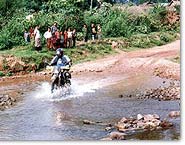
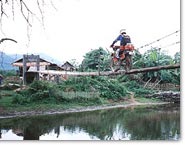
|
Every few
kilometers we have to cross a small river. Sometimes the water is clear
and you can look out for boulders lurking beneath the surface, but sometimes
you just have to take your chances. After every couple of river crossings
we stopped to wait for our backup car to catch up.
One by one
we have to cross a river over a hanging bridge, which starts swaying by
the time you're in the middle. Sitting on a motorbike on a swaying bridge
is definitely a weird feeling, and everybody has to stop in the middle
to wait until the bridge goes quiet before he can continue. Walter doesn't
supply a "snack sack" like they have on commercial airlines for people
turning green, but then there's the whole river to bless with the remains
of your breakfast...
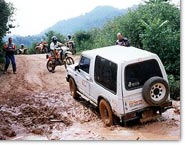 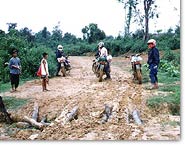 Sometimes
the bridges are just a few tree trunks, and most of us get stuck at least
once when the front or rear wheel simply disappears in a gap all the way
to the axle. Even with our lightweight bikes it usually takes two or three
of us to get them out. There's not much space to stand on, and the tree
trunks are muddy and very slippery. There are plenty of mud holes, and
we stop at a very deep one to help a group of men who are trying to drive
an ancient truck full of timber through it. These mud holes can be real
traps. Usually a trickle of water is constantly filling them up, and they
have a lot of soft deep mud beneath the surface. Once Walter crosses one
on the wrong side and gets so stuck that the bike stands up by itself!
While we waited for our 4WD backup car to help the truck, we had fun with
the mud hole, driving through it again and again. Sometimes
the bridges are just a few tree trunks, and most of us get stuck at least
once when the front or rear wheel simply disappears in a gap all the way
to the axle. Even with our lightweight bikes it usually takes two or three
of us to get them out. There's not much space to stand on, and the tree
trunks are muddy and very slippery. There are plenty of mud holes, and
we stop at a very deep one to help a group of men who are trying to drive
an ancient truck full of timber through it. These mud holes can be real
traps. Usually a trickle of water is constantly filling them up, and they
have a lot of soft deep mud beneath the surface. Once Walter crosses one
on the wrong side and gets so stuck that the bike stands up by itself!
While we waited for our 4WD backup car to help the truck, we had fun with
the mud hole, driving through it again and again.
Part
4: More fun coming right up!
Many thanks
to:
http://asiaplus.com/siambike/wheelies.html
Text and photographs © 1996-2000 by Siam Bike Travel Co., Ltd.
Top
of Page
|
